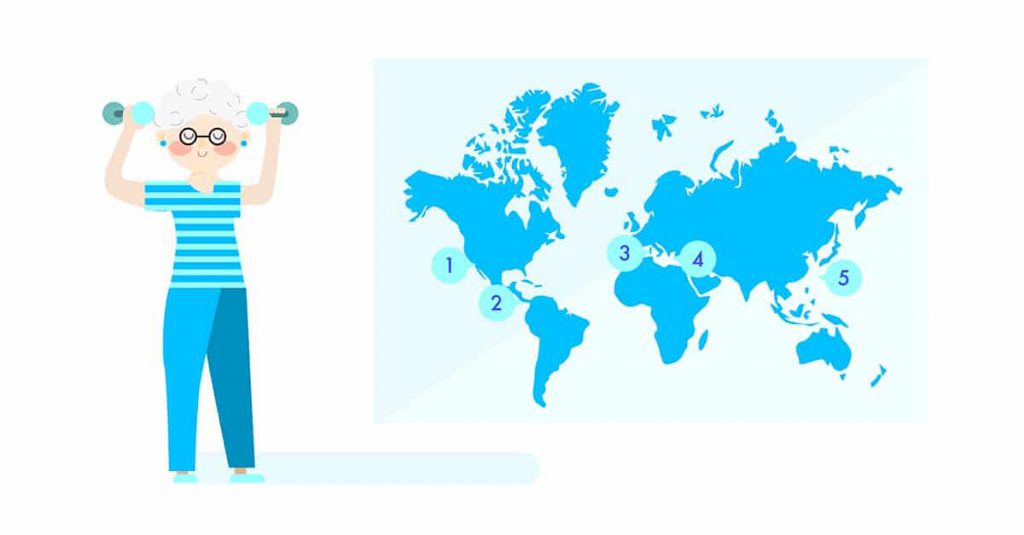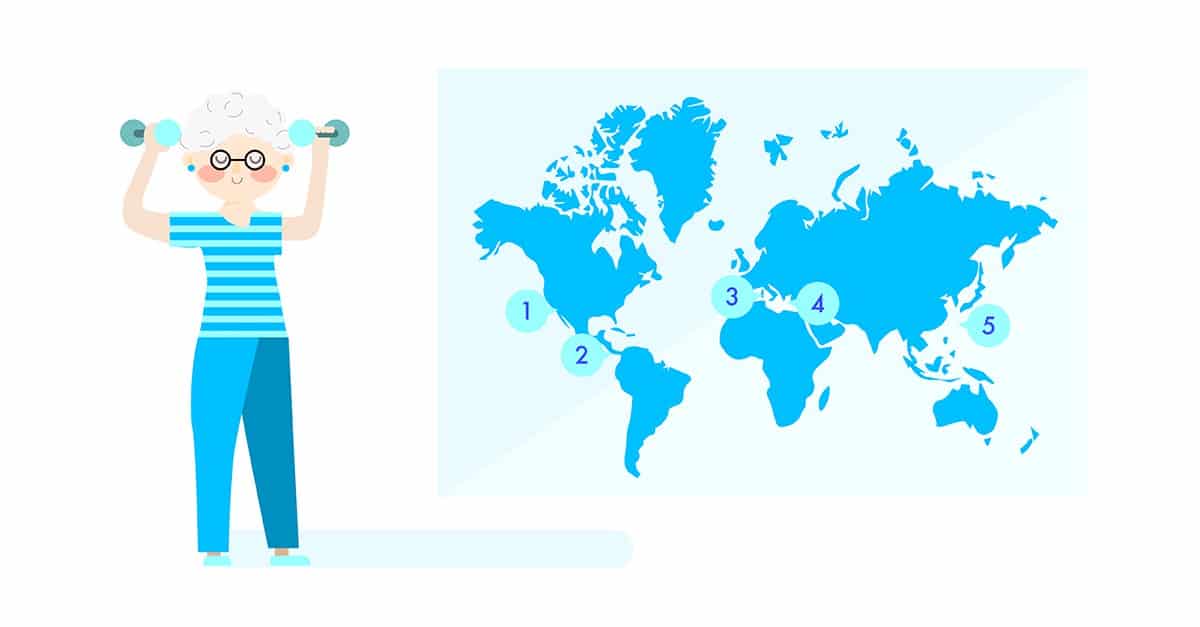
Those of us who read Tuck Everlasting in middle school have all grappled with the question posed by the young-adult book: Would you want to live forever?
Researchers haven’t invented a pill for infinite life (at least not yet), but they have figured out that it’s possible to increase your lifespan — no magical spring water required. You also don’t have to win the genetic lottery to add a decade or more to your life. It’s possible to live not only a longer life but a healthier one too with the adoption of some important lifestyle changes, as evidenced by the world’s Blue Zones. These zones, which represent five regions with unusually high concentrations of centenarians, or people who live longer than 100 years, may hold the key to a long and healthy life.
Want to know their secrets? Read on!
The Science of Longevity: Genetics or Environment?
For decades, scientists have been researching whether a person’s lifespan is influenced most by their genetics, their environment, or both.
More recent research suggests that human aging and longevity are affected by a combination of genetics and non-genetic factors, such as diet, access to clean drinking water and medical care, improvements in medical treatments, limited stress, and more. Perhaps surprisingly, genetics seem to account for only 20 to 25 percent of variations in lifespan. That means up to 80 percent of a person’s longevity is determined by lifestyle and environmental factors.
In general, human lifespans have lengthened as more people have access to clean drinking water, nutritious food, and medical care. But a longer lifespan isn’t necessarily a healthier one. In many cases, people’s lives are extended past a certain point only because of advancements in medical intervention. For this reason, researchers are now exploring whether it’s possible to extend the human “healthspan” — or a long and healthy life.

Introducing the Blue Zones
In 2004, National Geographic and National Institute of Aging expedition leader Dan Buettner traveled the world in a quest to better understand human longevity. Those travels led to the discovery of five so-called “Blue Zones” — regions where people reach the age of 100 at a rate 10 times higher than the general U.S. population.
The Blue Zones are:
- Ikaria, Greece, a small Aegean island that sticks to a Mediterranean diet
- Loma Linda, CA, USA, an Adventist community that embraces a vegan diet and a weekly rest day
- Nicoya, Costa Rica, where residents emphasize a positive outlook, active lifestyle, and sense of purpose
- Okinawa, Japan, South Pacific islands that boast strong social networks and the world’s longest-lived women
- Sardinia, Italy, a community of shepherds that’s home to the world’s longest-lived men
Based on extensive studies of the people living in these regions, Buettner and a team of anthropologists, demographers, and scientists identified nine common denominators for health and longevity, which are dubbed the Power 9. They also determined that these people spend approximately 90 percent of their lives within five miles of their homes, deemed the Life Radius. Based on that data, the team posited that optimizing the Life Radius would lead to significant improvements in people’s health and longevity.
Buettner and the team have since advocated for the Power 9 to be used as community guidelines that enable individuals to live healthier, longer lives. The Power 9 now inform policy making at many levels, from schools and businesses to government entities. Communities from Alberta Lea, MN, to Los Angeles, CA, have seen major improvements in health following the adoption of the Power 9 and Life Radius principles.
Lessons from the Blue Zones
While governmental and social resources are essential for ensuring everyone benefits from the Power 9, individuals can also pursue these habits on their own. Here’s a closer look at the nine everyday lifestyle habits that can increase anyone’s chances of living a longer, healthier life.
- Follow the 80 percent rule when eating
A 2,500-year-old Confucian mantra still reigns supreme in Okinawa: “Hara hachi bu” is a reminder to stop eating when your stomach is around 80 percent full so as to stave off weight gain. People in the Blue Zones generally eat their smallest meal in the late afternoon or early evening, and they don’t snack after that.
- Eat more legumes
Beans really could be a magical fruit. Most centenarians eat plenty of legumes, including black beans, fava beans, lentils, and soybeans — so you may want to incorporate more of these into your diet. While you’re at it, aim to eat less meat and dairy, a habit which can lower the risk of death.
- Consider a glass of wine at 5 o’clock
Excluding the Adventists in Loma Linda, CA, people living in the Blue Zones drink alcohol on a regular basis — in moderation — and the regional drinkers tend to out-live those who abstain. They generally drink one or two glasses of wine per day, enjoyed with friends and/or food. (Obviously, this is not a healthy choice for people who are prone to alcoholism.)
- Adopt stress-relieving habits
In the language of the Blue Zones research, stress-relieving habits also go by the term “Downshift.” The idea is to cultivate daily routines that help shed stress, which is associated with chronic inflammation and age-related disease. Centenarians living in the Blue Zones don’t live stress-free lives, but they do take steps to manage their stress. Okinawans spend a few moments each day honoring their ancestors, while the Adventists of Loma Linda pray, Ikarians take a nap, and the Sardinians kick back with a happy hour.
- Move naturally and often
There’s no need to crush a monthly marathon or spend all your free time in the gym. Instead, everyday activity may contribute to a longer life. Think puttering around in the garden, doing housework, walking instead of driving, and so on.
- Prioritize family
Folks living in the Blue Zones tend to put family first. They take care of aging parents or grandparents, devote time to their children, and tend to create a lifelong bond with a partner, which can add up to three years to a person’s life expectancy.
- Find a spiritual center
Out of 263 centenarians interviewed for the Blue Zones project, all but five belonged to a faith-based community. This doesn’t mean you need to become devoutly religious if that doesn’t align with your beliefs. But joining a community that’s devoted to a higher purpose can increase longevity.
- Cultivate a sense of purpose
In both Okinawa and Nicoya, long-living residents wake up every morning with a why — a sense of purpose that motivates them to stay involved in their lives. The Blue Zones research suggests that living with a sense of purpose can add up to seven years of extra life expectancy.
- Build healthy social circles
Whether you were born into a close-knit community or you’re building one, healthy social ties will pay off for years to come by promoting healthy behaviors and boosting happiness. On the other hand, research suggests smoking, loneliness, and other negative health issues can actually be contagious. Cultivate a strong social network by joining local community groups, volunteering, and so on.
Conclusion
Some of these habits may seem straightforward, while others require more effort or support. But gradually incorporating the Power 9 into your life can pay off in big ways, from enhanced health and happiness to a longer life. In fact, research suggests the average person’s life expectancy could rise by 10 to 12 years by adopting a Blue Zones lifestyle. In the words of Blue Zones researcher Dan Buettner, “Living longer and feeling better is the sum of a few small, easy choices you can incorporate into everyday life.”
